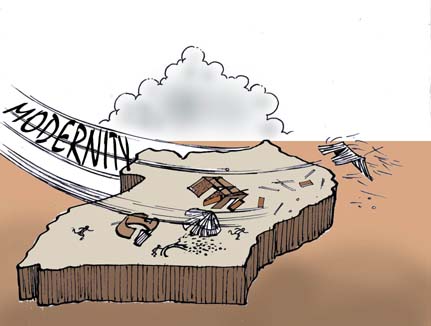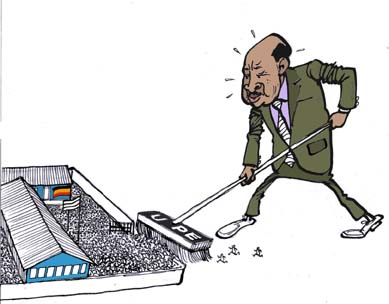|
|
 |
|
What is Uganda today? It is first, as it has always been, a land of rich soils and good climate. These have supported a trebling of the population in the last 30 years to approximately 26 million people. Most Ugandans still live on the land and more of Uganda’s wealth comes from agriculture (42%) than from either industry or services (38% and 20% respectively). But Uganda is also a landlocked country wrapped around the shores of Lake Victoria. As it leaves the lake, the country winds through the swamps and rapids of the Nile River, sitting between the Ruwenzori Mountains to This diversity may be Uganda’s greatest wealth, but since the 1960’s – around about when Uganda gained independence – the country has undergone spells of political violence that have resulted in loss of lives and unconstitutional power changes. In 1986, the National Resistance Movement came to power. With this, a relative period of calm was ushered in with many parts of the country enjoying peace and stability. Only Northern Uganda continues to suffer insecurity due to armed insurgencies. What we have achieved in recent years Many people today laud Uganda as a great success story – and they are right in many ways. Since 1987, we have enjoyed a sustained period of economic growth. Liberalization and privatisation have created new opportunities and a growing middle class; new businesses have opened; urbanization has created new suburbs for the new middle class who enjoys better infrastructure and services, indeed a better standard of life. In spite of their imperfections, political, institutional and structural changes have also taken place allowing for better management of society. Emerging from a state of decay and collapse, the country has made considerable progress towards institutionalisation of governance processes. The Local Council system, a robust parliament, an improved and functional judiciary as well as a fairly disciplined military are all evidence of institution building. There have been highly visible attempts to fight corruption through the establishment of the Inspector General of Government, the Special Revenue Protection Services, the police as well as various commissions of inquiry.
The Universal Primary Education (UPE) programme launched in 1997 has led to a hitherto unprecedented number of children attending school. Enrolment increased from less than a million at the start of the programme to some seven million children within six years of its launch. Similarly, at the start of the 1980’s, there were only two universities. At the start of 2004, there were over 15 universities in operation around the country. But what else is going on in Uganda? What has been the price of this success? |
| [Home] [Uganda Today] [The Price Paid] [Challenges] [Why like this?] [About Scenarios] [The Rope Bridge] [Ow'embaliga] [Ovago Vile Vile] [Comparisons, 1] [Comparisons, 2] [Comparisons, 3] [Comparisons, 4] [Comparisons, 5] [About SID] |
|
Society for International Development |
 the west and Mount Elgon to the east. This landscape has supported a rich diversity of wildlife and of peoples, languages and traditions. These include political legacies of both kingdoms and acephalous bands ruled by groups of elders. Religious life is as varied as the landscape and the language. Here, too, diversity is the rule.
the west and Mount Elgon to the east. This landscape has supported a rich diversity of wildlife and of peoples, languages and traditions. These include political legacies of both kingdoms and acephalous bands ruled by groups of elders. Religious life is as varied as the landscape and the language. Here, too, diversity is the rule. Uganda has also risen to the challenge of HIV/AIDS, an epidemic that led to the death of many Ugandans. The disease has been fought with courage at all levels. Massive education and awareness drives have seen incidences of infection decline, particularly in the urban areas where HIV prevalence has fallen from 31% at the start of the 1990s down to 5% at the end of that decade.
Uganda has also risen to the challenge of HIV/AIDS, an epidemic that led to the death of many Ugandans. The disease has been fought with courage at all levels. Massive education and awareness drives have seen incidences of infection decline, particularly in the urban areas where HIV prevalence has fallen from 31% at the start of the 1990s down to 5% at the end of that decade.